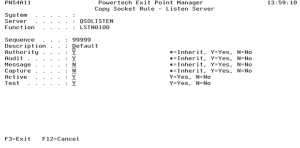How to Get There
On Work with Socket Rules - Accept Server, Work with Socket Rules - Connect Server, or Work with Socket Rules - Listen Server, enter option 3 next to a rule.
What it Does
The Copy Socket Rule panel allows you to copy a Socket Rule.
Field Descriptions
System
System indicates the target of any operations you perform. When you add rules, for example, those rules will be sent to, and will affect processing on, the System named.
Server
A Server in Powertech Exit Point Manager for IBM i is a controlled entry point into your system. These entry points are determined and defined by IBM. Powertech Exit Point Manager for IBM i has assigned easy-to-remember names to these controlled entry points.
Function
A Function, or Server Function, in Powertech Exit Point Manager for IBM i represents a class of operations that a given Server may perform. For example, the *SIGNON Server classifies its operations as those pertaining to changing passwords, generating authentication tokens, and retrieving signon information. Powertech Exit Point Manager for IBM i has assigned easy-to-remember names to these Functions, such as CHGPWD, GENAUTTKN and RETRIEVE.
Sequence
The sequence number of a Socket Rule determines the order in which it will be evaluated by the exit program, with the lowest sequence number being evaluated first. Socket Rules are evaluated until a match is found.
Description
The Socket Rule description is a short textual description of the Socket Rule. It is typically used to indicate the purpose of the Socket Rule.
Authority
Authority represents the action to be taken when a rule is found that matches the data present on a transaction.
The valid values are:
The value * will cause the rule to inherit the value from the default Socket Rule (sequence number 99999). This default rule may not be set to the value *.
Audit
The Audit flag controls the logging of transactions to the Log Journal set up on the Work with Powertech Exit Point Manager for IBM i System Values panel.
The valid values are:
The value * will cause the rule to inherit the value from the default Socket Rule (sequence number 99999). This default rule may not be set to the value *.
Message
The Message flag controls the sending of messages to the Log Message Queue set up on the Work with Powertech Exit Point Manager for IBM i System Values panel.
The valid values are:
The value * will cause the rule to inherit the value from the default Socket Rule (sequence number 99999). This default rule may not be set to the value *.
Capture
The Capture flag controls whether transactions are remembered in Powertech Exit Point Manager for IBM i. Unlike some other rule types, a captured Socket Rule cannot be memorized.
The valid values are:
The value * will cause the rule to inherit the value from the default Socket Rule (sequence number 99999). This default rule may not be set to the value *.
Active
The Socket Rule Active flag determines whether the rule will be evaluated by the exit point program.
It can be useful to initially set a Socket Rule as not active in order to test it without enforcing it.
The valid values are:
The value N is not allowed for the default Socket Rule (sequence number 99999).
Test
The Socket Rule Test flag determines whether the rule will be evaluated by the Socket Rule test facility.
It can be useful to flag a rule to not be tested in order to verify the effects of removing that rule.
The value N is not allowed for the default Socket Rule (sequence number 99999).
The valid values are:
Command Keys
F3 (Exit): Exit the panel without processing any pending changes.
F12 (Cancel): Exit the panel without processing any pending changes.
